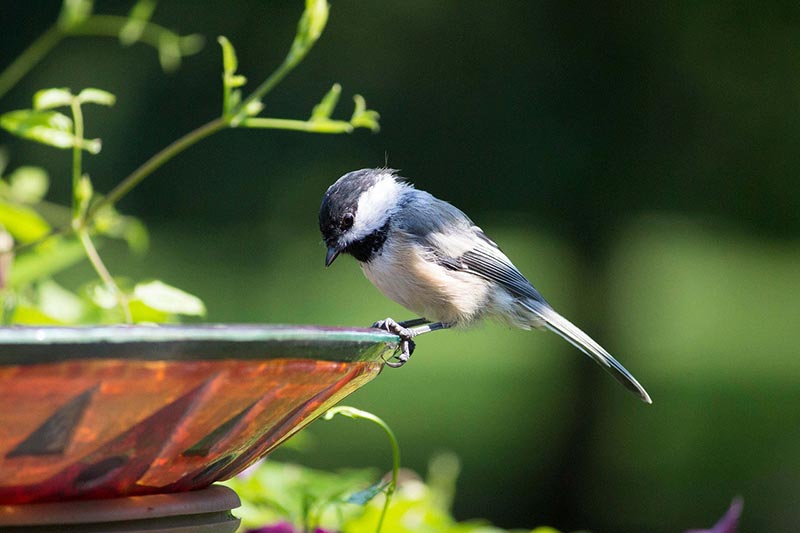How To Attract Chickadees to Your Yard (7 Great Ideas)
Last Updated on

Named after their distinctive call, the Chickadee is a delightful and adorable bird that brings much joy to any human who has the pleasure of spotting one in their yard. Chickadees are bold little birds that are not intimidated by humans, and some humans are able to build trust with the bird and eventually train them to eat from their hands.
That is just one reason people want to attract the charming birds to their yard and encourage them to visit. Fortunately, they are easy to please, and we have put a list of great ideas to help you attract the sweet and curious Chickadees to your yard.

The 7 Ways to Attract Chickadees To Your Yard:
1. Attract Chickadees with Feeders They Love

Bird feeders are one of the most reliable sources of attracting Chickadees to your garden. Chickadees enjoy most feeders as long as they are filled with food they enjoy, but it is best to use small feeders that only small birds like Chickadees can use. The market is filled with all sorts of bird feeder options, but Chickadees are known to prefer tube feeders, hopper feeders, and platform feeders.
2. Attract Chickadees with Their Favorite Food

Chickadees eat a variety of foods and usually spend most of their days searching for something to snack on. In summer, they usually eat large insects, and in winter, their diet mostly consists of seeds and berries.
- Black oil sunflower seeds: Sunflower seeds are hard for a Chickadee to resist.
- Shelled peanuts: Chickadees love these tasty nuts. They are a great source of protein and fat, which are especially important for their diets in winter.
- Safflower: Safflower seed is regularly enjoyed by Chickadees, and the best part about including it in your bird feeder is that other ‘problem’ birds, like grackles and starlings, will ignore it.
- Suet: Suet is the hard fat of beef or lamb and is one of the Chickadee’s favorite foods.
- Mealworms: Chickadees naturally love insects, and adding this delicious source of fat and protein to your feeder will quickly attract Chickadees to your yard.
3. Attract Chickadees with Clean Water in A Birdbath

Chickadees will visit a bird bath for a drink, but shallow baths are required because they are small birds. If a basin is too deep, scattering river rocks or gravel along the bottom or placing a smaller dish inside it can make it more suitable for Chickadees.
Water that is not clean can spread illness or disease, and Chickadees will not drink or bathe in it. You should clean the water daily and deep clean the surface if it becomes particularly dirty.
Bird baths are ideal because they provide fresh water and are visually appealing in any yard!
4. Attract Chickadees with Nesting Sites

Chickadees are known as “cavity-nesters,” which means they roost in cavities (such as holes in dead trees). A regular birdhouse mimics the conditions of a cavity nest, providing a safe haven for your Chickadees to nest. While Chickadees can be creative with their house designs, the ideal size is 8 inches tall with a 4- or 5-inch square base and a 1 1/8-inch entrance hole. Chickadee houses should be mounted 4–15 feet above the ground on a tree, wall, or pole. Offering nesting materials like wood shavings and sawdust will encourage Chickadees to nest, and it can help to place the birdhouse close to the feeder.
5. Plant Berry Producing Shrubs and Flowering Trees

Chickadees enjoy eating insects, and you can grow berry-producing shrubs, flowering trees, and sunflowers to attract bugs. They will also enjoy eating the berries and sunflower seeds, and you will most likely see Chickadees in your yard every day!
6. Attract Chickadees with Shelter

Chickadees seek shelter in deciduous and coniferous trees and dense shrubbery. Evergreen trees and shrubs are essential for winter Chickadee shelters, and Chickadees generally prefer them because they provide protection and camouflage all year round. They will readily use roosting boxes or empty birdhouses to stay warm in cold weather. If possible, keep a dense thicket or a thick row of shrubbery to provide the Chickadees with a quick hiding space if they ever feel threatened.
7. Don’t Use Pesticides Near Your Home

Pesticides can be hazardous to human health, the animals that gardeners seek to support and attract, and the plants that feed them. Using pesticides can harm any Chickadee that may visit your garden. They can coat the seeds or berries the bird ingests and kill off any insects they typically eat. Using DIY pesticides and weeding by hand are just some of the ways you can avoid using synthetic and harmful pesticides.

Chickadee Predators and Threats
As small birds, Chickadees must watch for predators from above, such as Shrikes, hawks, and owls.
Tree-climbing mammals such as cats and raccoons pose the greatest threat to eggs and young birds. Because the birds prepare multiple nest sites, they are able to avoid predators. If a predator discovers a nest, they will build another somewhere else.

Fun Facts About Chickadees
Here are a few fun facts about the Chickadee that will deepen your appreciation for them.
- They are named after their alarm call, “chick-a-dee-dee-dee.” The amount of “dees” is used to identify the predator.
- They build a nest for each brood which is up to two per year.
- Chickadees’ wing beats are about 27 times per second!
- Chickadees weigh less than half an ounce.
- Chickadees hide food for later and will hide each item in a different spot, remembering thousands of hiding places.
- Chickadees allow neurons that contain old, useless information to die and new ones to form so that they can adapt to changes. That’s the same as forgetting old phone numbers in order to make room for new email addresses.

Final Thoughts
The fascinating and charming Chickadee is easy to lure into your backyard. By following these tips, you can enjoy the pleasure of their company at your feeder or birdhouse. The more they visit, the more trust they will gain, and perhaps before you know it, you will have one of the cuties eating out the palm of your hand. While offering food and shelter and a variety of shrubs and bushes will attract these birds to your yard, be mindful of possible threats such as pets and pesticides.
Featured Image Credit: MDDECE, Pixabay
Table of Contents
- The 7 Ways to Attract Chickadees To Your Yard:
- 1. Attract Chickadees with Feeders They Love
- 2. Attract Chickadees with Their Favorite Food
- 3. Attract Chickadees with Clean Water in A Birdbath
- 4. Attract Chickadees with Nesting Sites
- 5. Plant Berry Producing Shrubs and Flowering Trees
- 6. Attract Chickadees with Shelter
- 7. Don’t Use Pesticides Near Your Home
- Chickadee Predators and Threats
- Fun Facts About Chickadees
- Final Thoughts
About the Author Robert Sparks
Robert’s obsession with all things optical started early in life, when his optician father would bring home prototypes for Robert to play with. Nowadays, Robert is dedicated to helping others find the right optics for their needs. His hobbies include astronomy, astrophysics, and model building. Originally from Newark, NJ, he resides in Santa Fe, New Mexico, where the nighttime skies are filled with glittering stars.
Related Articles:
How to Collimate Binoculars: 9 Expert Tips
How to Clean a Refractor Telescope: Step-by-Step Guide
How to Clean a Telescope Eyepiece: Step-by-Step Guide
How to Clean a Rifle Scope: 8 Expert Tips
Can You Use Binoculars to Look At Stars? How to Choose the Right Pair
How to Choose Binoculars for Bird Watching: 10 Expert Tips
10 Types of Hummingbirds in Arkansas (With Pictures)
8 Types of Hummingbirds in Nebraska (With Pictures)
